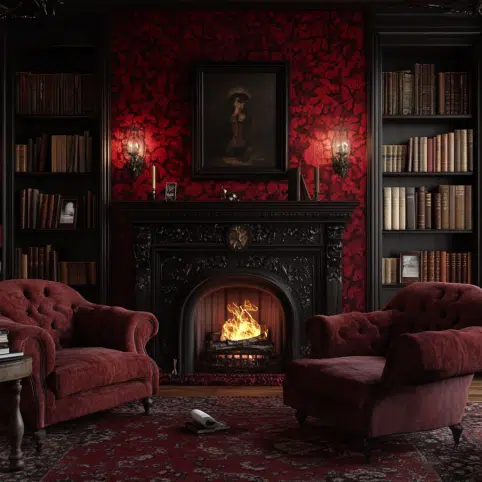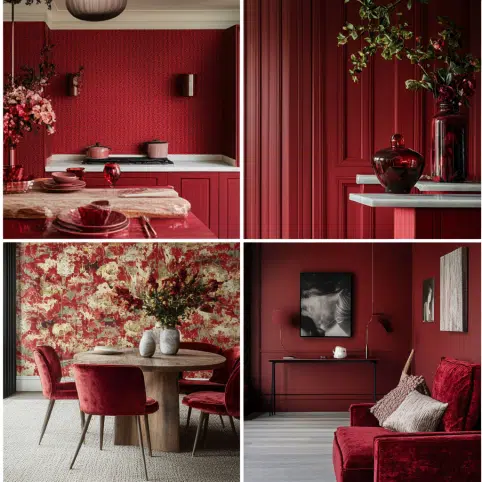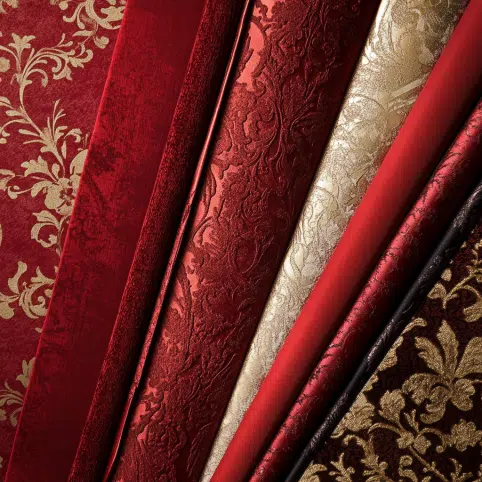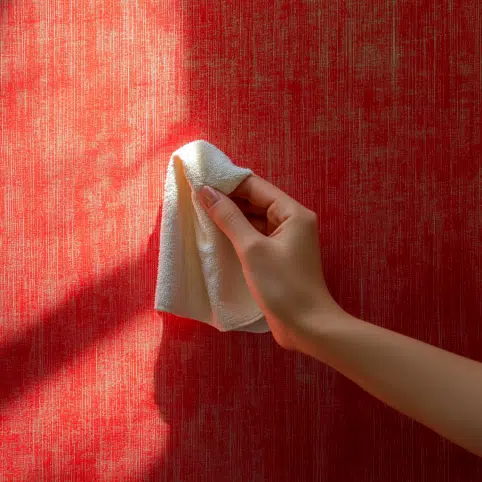Red Wallpaper
Transform Your Space with Bold Elegance
The Psychology of Red Wallpaper: How It Influences Mood and Atmosphere?
In addition to stimulating energy, red wallpaper can evoke feelings of warmth and comfort. This is especially true for deeper, richer shades of red, such as burgundy or maroon, which create a cozy and inviting ambiance. Bedrooms or reading nooks adorned with dark red wallpaper can feel intimate and secure, providing a sense of relaxation and comfort. These darker tones wrap the room in warmth, making it an ideal space for unwinding after a long day. Pairing red wallpaper with soft lighting and plush textures further enhances this soothing effect, turning the room into a peaceful retreat.
The psychology of color plays a significant role in interior design, influencing how people feel and interact with a space. Among the many color choices available, red stands out as one of the most powerful and dynamic. When incorporated through wallpaper, red has a profound effect on mood and atmosphere, transforming ordinary rooms into vibrant, intimate, or even luxurious spaces. Understanding how red wallpaper impacts emotions and behaviors can help in making thoughtful design choices that enhance a room’s functionality and aesthetic appeal.
Red is widely recognized as a color of passion, energy, and warmth. Psychologically, it is known to stimulate emotions and increase energy levels. When used in wallpaper, red can invigorate a space, making it feel more alive and engaging. This quality makes red wallpaper an excellent choice for social areas in the home, such as living rooms, dining rooms, or entertainment spaces. In these settings, red wallpaper fosters conversation, liveliness, and a welcoming atmosphere. Its bold nature naturally draws attention and becomes a focal point, encouraging interaction and creating a dynamic environment.
However, the psychological impact of red wallpaper is highly dependent on its intensity and the way it is used. Bright, bold reds can be energizing but may also become overwhelming if used excessively. In small or confined spaces, too much vibrant red wallpaper can lead to feelings of restlessness or agitation. To avoid this, it’s essential to balance bold red wallpaper with neutral or softer tones in the room. Using red as an accent wall or incorporating patterns that blend red with more subdued colors can create a balanced, stimulating atmosphere without being overpowering.
The texture and pattern of red wallpaper also play a role in how it influences mood. Smooth, glossy red wallpaper can amplify energy and excitement, reflecting light and creating a vibrant atmosphere. In contrast, matte or textured red wallpaper can soften the intensity of the color, offering a more grounded and sophisticated feel. Patterns featuring red tones, such as florals, damasks, or geometric designs, can introduce visual interest and break up large expanses of bold color, preventing the space from feeling too intense.

Culturally, red holds different meanings that can influence how it’s perceived in wallpaper design. In many Eastern cultures, red symbolizes luck, prosperity, and happiness, making it a popular choice for celebratory spaces or significant areas within a home. In Western cultures, red is often associated with love, passion, and power. These cultural associations can impact how individuals feel about red wallpaper in their personal spaces. By understanding these cultural influences, homeowners can choose red wallpaper that resonates personally and culturally, enhancing the intended mood of a room.
Red wallpaper is also known to have subtle physical effects on people. Studies in color psychology suggest that red can increase heart rate and stimulate appetite, which explains why it is often used in dining rooms and kitchens. In these spaces, red wallpaper can encourage appetite and make meals feel more lively and enjoyable. This psychological effect makes red an excellent choice for areas designed for gathering and social interaction.
In creative or professional environments, red wallpaper can inspire action and determination. A study or home office with carefully chosen red wallpaper might foster a sense of urgency and motivation, encouraging productivity and focus. However, it’s important to strike a balance to prevent overstimulation, which can lead to stress or fatigue. Combining red wallpaper with calming décor elements can maintain focus without causing discomfort.
The lighting in a room can also impact how red wallpaper influences mood. Natural light can make red hues appear brighter and more vibrant, enhancing energy during the day. In contrast, soft, warm lighting in the evening can deepen red tones, creating a more intimate and cozy atmosphere. Understanding how lighting interacts with red wallpaper is crucial to achieving the desired mood and ambiance in a space.
Top Design Ideas for Decorating with Red Wallpaper in Every Room
The psychology of color plays a significant role in interior design, influencing how people feel and interact with a space. Among the many color choices available, red stands out as one of the most powerful and dynamic. When incorporated through wallpaper, red has a profound effect on mood and atmosphere, transforming ordinary rooms into vibrant, intimate, or even luxurious spaces. Understanding how red wallpaper impacts emotions and behaviors can help in making thoughtful design choices that enhance a room’s functionality and aesthetic appeal.
Red is widely recognized as a color of passion, energy, and warmth. Psychologically, it is known to stimulate emotions and increase energy levels. When used in wallpaper, red can invigorate a space, making it feel more alive and engaging. This quality makes red wallpaper an excellent choice for social areas in the home, such as living rooms, dining rooms, or entertainment spaces. In these settings, red wallpaper fosters conversation, liveliness, and a welcoming atmosphere. Its bold nature naturally draws attention and becomes a focal point, encouraging interaction and creating a dynamic environment.
In addition to stimulating energy, red wallpaper can evoke feelings of warmth and comfort. This is especially true for deeper, richer shades of red, such as burgundy or maroon, which create a cozy and inviting ambiance. Bedrooms or reading nooks adorned with dark red wallpaper can feel intimate and secure, providing a sense of relaxation and comfort. These darker tones wrap the room in warmth, making it an ideal space for unwinding after a long day. Pairing red wallpaper with soft lighting and plush textures further enhances this soothing effect, turning the room into a peaceful retreat.

However, the psychological impact of red wallpaper is highly dependent on its intensity and the way it is used. Bright, bold reds can be energizing but may also become overwhelming if used excessively. In small or confined spaces, too much vibrant red wallpaper can lead to feelings of restlessness or agitation. To avoid this, it’s essential to balance bold red wallpaper with neutral or softer tones in the room. Using red as an accent wall or incorporating patterns that blend red with more subdued colors can create a balanced, stimulating atmosphere without being overpowering.
The texture and pattern of red wallpaper also play a role in how it influences mood. Smooth, glossy red wallpaper can amplify energy and excitement, reflecting light and creating a vibrant atmosphere. In contrast, matte or textured red wallpaper can soften the intensity of the color, offering a more grounded and sophisticated feel. Patterns featuring red tones, such as florals, damasks, or geometric designs, can introduce visual interest and break up large expanses of bold color, preventing the space from feeling too intense.
Culturally, red holds different meanings that can influence how it’s perceived in wallpaper design. In many Eastern cultures, red symbolizes luck, prosperity, and happiness, making it a popular choice for celebratory spaces or significant areas within a home. In Western cultures, red is often associated with love, passion, and power. These cultural associations can impact how individuals feel about red wallpaper in their personal spaces. By understanding these cultural influences, homeowners can choose red wallpaper that resonates personally and culturally, enhancing the intended mood of a room.
Red wallpaper is also known to have subtle physical effects on people. Studies in color psychology suggest that red can increase heart rate and stimulate appetite, which explains why it is often used in dining rooms and kitchens. In these spaces, red wallpaper can encourage appetite and make meals feel more lively and enjoyable. This psychological effect makes red an excellent choice for areas designed for gathering and social interaction.
In creative or professional environments, red wallpaper can inspire action and determination. A study or home office with carefully chosen red wallpaper might foster a sense of urgency and motivation, encouraging productivity and focus. However, it’s important to strike a balance to prevent overstimulation, which can lead to stress or fatigue. Combining red wallpaper with calming décor elements can maintain focus without causing discomfort.
The lighting in a room can also impact how red wallpaper influences mood. Natural light can make red hues appear brighter and more vibrant, enhancing energy during the day. In contrast, soft, warm lighting in the evening can deepen red tones, creating a more intimate and cozy atmosphere. Understanding how lighting interacts with red wallpaper is crucial to achieving the desired mood and ambiance in a space.
Choosing the Perfect Red Wallpaper: Patterns, Textures, and Finishes
Choosing the perfect red wallpaper involves a thoughtful balance of patterns, textures, and finishes to create a space that feels both stylish and inviting. Red wallpaper is a bold design choice that can dramatically transform the look and mood of a room, offering warmth, energy, and sophistication. However, selecting the right combination of design elements is essential to achieving the desired aesthetic. By understanding how different patterns, textures, and finishes interact with the space, you can make informed decisions that elevate your interior design.
The pattern of red wallpaper plays a significant role in shaping the overall atmosphere of a room. Bold, large-scale patterns, such as florals, damasks, or geometric prints, can make a dramatic statement and serve as the focal point of a space. These patterns work especially well in larger rooms or on feature walls where they have enough space to be appreciated without overwhelming the room. For a more understated look, smaller-scale prints or subtle tone-on-tone patterns provide visual interest without dominating the space. Stripes, for example, can add a sense of height or width to a room depending on their orientation, while abstract or watercolor designs introduce a softer, more artistic flair.
Incorporating patterns with complementary colors can also enhance the impact of red wallpaper. Red paired with metallic gold or silver accents can evoke a sense of luxury and glamour, while red combined with neutral tones like white, beige, or gray creates a balanced and contemporary feel. For those seeking a bold, eclectic design, red wallpaper featuring contrasting colors such as navy blue or emerald green can add depth and richness. When selecting patterned wallpaper, it’s important to consider how it will interact with the existing furniture and décor to ensure a cohesive design.
Texture is another key element in choosing the perfect red wallpaper. Textured wallpaper adds depth and dimension to walls, making a space feel more dynamic and engaging. For example, a red wallpaper with a velvet or suede finish can create a luxurious, tactile surface that adds warmth and softness to a room. Grasscloth wallpaper in a muted red hue introduces a natural, organic texture that works well in rustic or bohemian-inspired interiors. Embossed or raised patterns can also bring a sense of sophistication and detail to the design, providing a subtle yet impactful visual effect.
Smooth finishes, such as satin or silk-like wallpaper, offer a sleek and polished look that works well in modern or minimalist spaces. These finishes reflect light subtly, adding a soft glow to the room without being overpowering. In contrast, matte finishes in red wallpaper offer a more understated elegance, ideal for creating cozy, intimate environments. The choice between smooth and textured wallpaper depends on the mood you want to establish and how much visual interest you wish to add to the space.

The finish of red wallpaper is equally important in determining the overall effect of the design. Glossy or metallic finishes can make a space feel glamorous and vibrant by reflecting light and adding a shimmering effect. These finishes are especially effective in formal spaces like dining rooms, entryways, or even powder rooms where a touch of drama is desired. On the other hand, matte finishes absorb light and offer a more subtle, sophisticated appearance, making them suitable for bedrooms or living rooms where a calm and cozy atmosphere is preferred.
Another finish to consider is a pearl or satin sheen, which offers a soft, elegant glow without the intense shine of a high-gloss finish. This type of wallpaper can strike the perfect balance between boldness and refinement, making it a versatile option for various spaces. For a contemporary look, red wallpaper with metallic foil accents or iridescent finishes can create a stunning visual impact, especially when paired with modern furnishings and décor.
When selecting red wallpaper, it’s also important to think about how the chosen pattern, texture, and finish will interact with the room’s size and lighting. In smaller spaces, large-scale patterns or dark, matte finishes can make the room feel more enclosed, while lighter shades of red or wallpapers with subtle patterns can help the space feel more open and airy. In well-lit rooms, glossy and metallic finishes can enhance the natural light, making the room feel brighter and more energetic. In contrast, matte or textured finishes work well in dimly lit spaces, creating a cozy and inviting ambiance.
Additionally, consider how the red wallpaper will complement the existing furniture and décor. If the room already features bold or colorful furniture, a more subdued red wallpaper with minimal patterns may be the best choice to avoid visual clutter. Conversely, if the space is furnished with neutral or minimalist pieces, a bold patterned red wallpaper can add the perfect touch of personality and vibrancy.
Maintenance and Care Tips for Keeping Your Red Wallpaper Vibrant
Red wallpaper adds a bold and elegant touch to any space, making a striking statement that enhances the overall atmosphere of a room. However, maintaining the vibrancy and beauty of red wallpaper requires proper care and attention. Over time, factors such as dust, sunlight, humidity, and accidental stains can dull the rich tones and intricate patterns of the wallpaper. By following effective maintenance and care practices, you can preserve the color and texture of red wallpaper, ensuring that it remains a stunning feature in your home for years to come.
One of the most important aspects of maintaining red wallpaper is regular cleaning. Dust and dirt can accumulate on wallpaper surfaces, especially in high-traffic areas or rooms with open windows. Regular dusting helps prevent buildup that can dull the color and texture of the wallpaper. Using a soft microfiber cloth or a vacuum cleaner with a brush attachment is an effective way to remove dust without damaging the wallpaper. Gently wiping the surface in smooth, circular motions prevents abrasion and keeps the wallpaper looking fresh. For more delicate wallpapers with intricate patterns or textured finishes, a feather duster can be used to clean hard-to-reach areas without applying pressure.
For wallpapers that are labeled as washable or scrubbable, occasional spot cleaning can help address stains and smudges. It’s essential to test a small, inconspicuous area of the wallpaper before applying any cleaning solution to ensure it doesn’t damage the color or finish. A solution of mild soap and lukewarm water applied with a soft sponge can be used to gently clean the surface. Avoid using abrasive cleaners, harsh chemicals, or rough scrubbers, as these can strip the color or damage the wallpaper’s texture. After cleaning, lightly blot the area with a dry, soft cloth to remove any moisture and prevent water stains.

Protecting red wallpaper from direct sunlight is crucial for maintaining its vibrancy. Prolonged exposure to sunlight can cause the rich red tones to fade over time, leaving the wallpaper looking dull and washed out. To prevent this, it’s advisable to install curtains, blinds, or UV-protective window films to limit the amount of sunlight entering the room. Rotating furniture and wall décor periodically can also help ensure that certain areas of the wallpaper are not consistently exposed to sunlight, promoting even wear and color retention throughout the room.
Humidity and moisture can be particularly damaging to wallpaper, especially in rooms like kitchens and bathrooms where steam and condensation are common. Excess moisture can lead to peeling, bubbling, or mold growth behind the wallpaper. To combat this, it’s important to maintain proper ventilation in these areas. Installing exhaust fans or using dehumidifiers can help control humidity levels and prevent moisture damage. In bathrooms or kitchens, opting for moisture-resistant wallpaper materials designed for high-humidity environments can provide additional protection and durability.
Preventing physical damage is another essential part of wallpaper maintenance. Sharp or heavy objects placed too close to wallpapered walls can cause scratches, dents, or tears. Taking care when moving furniture, hanging artwork, or installing shelves can prevent accidental damage. Using furniture pads or bumpers behind chairs and tables that are placed near wallpapered walls can minimize the risk of scuffs or marks. Additionally, teaching children and guests to handle walls with care can go a long way in preserving the pristine look of red wallpaper.
Addressing minor tears or peeling promptly can prevent further damage and maintain the seamless appearance of the wallpaper. If a small section begins to peel, applying a thin layer of wallpaper adhesive behind the loose edge and pressing it back into place can help restore the wallpaper. For more noticeable tears or damage, consulting with a professional wallpaper installer may be the best solution to ensure proper repair without compromising the overall design.
Another long-term strategy for preserving the look of red wallpaper is to keep the air quality clean within the home. Smoke from candles, fireplaces, or cigarettes can discolor wallpaper over time. Using air purifiers and ensuring proper ventilation can minimize airborne particles that might settle on the wallpaper and cause discoloration. Opting for unscented or low-soot candles and keeping open flames away from wallpapered walls also helps prevent staining.
Choosing the right wallpaper materials and finishes from the start can also contribute to easier maintenance and long-lasting vibrancy. Vinyl-coated and washable wallpapers are more durable and resistant to stains, making them ideal for busy areas. Matte or textured finishes may require more delicate care, while glossy finishes might show fingerprints and smudges more easily but are often easier to clean. Understanding the specific care requirements of the wallpaper material can guide proper maintenance routines.
We invite you to visit our pages on 1A Group
For more information visit 1awallpaper.com
